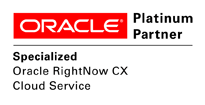Blog by Ed Hague-Holmes
Cache me if you can: Location logging in Oracle B2C Service using a what3words integration
5 min read
We recently took part in a conference organised by Richard Lefebvre (EMEA CRM & HCM Partners Program Director), where Christopher Patterson (Senior Director for Oracle Product Development) discussed the Oracle Service Cloud roadmap for 2014/2015 and the general direction that Oracle intends for the Service Cloud offering.
This is the first of two blog posts, which will give an overview of the intended strategic improvements for Service Cloud coming in the near future. This blog post will discuss a number of potential advances to the Customer Portal, including improvements to Virtual Assistant, Syndicated Widgets and Chat.
Virtual Assistant has only recently been released but Oracle are already extending its functionality. As mentioned in our previous RightNow roadmap blog post, Virtual Assistant is a self-service tool which enables the user to use natural language to communicate and find the information they are looking for. The Virtual Assistant responds to the user’s questions by suggesting relevant answers that are already stored in the knowledgebase or by directing them to useful information held within the website.
The latest release extends the functionality mentioned above, Virtual Assistant now incorporates the context of the page the customer was viewing in their dialogue enabling Virtual Assistant to ask increasingly relevant questions and reach a solution quicker.
Figure 1: Future improvements to Virtual Assistant
Moving forward Oracle intends to invest more in the use of community-driven solutions and content in Service Cloud. They are looking into a more seamless integration of the Community and Knowledge Base channels. Full unification will allow end users to see both best answers from the knowledge base and the answers given by the community and will limit unnecessary duplication. The introduction of a shared taxonomy and structure, such as shared products and categories, will make it easier to search across the community and knowledge base and is expected to help companies better understand their customer’s behaviour. It will also be a single place where optimisation will bring benefits to the whole application at once, not just in one specific component. Furthermore, it allows for better tuned and automated machine learning.
Figure 2: Integration of Community and Knowledge Base channels
Another piece of all new functionality which we expect to be released soon is a very basic form of A/B testing. A/B testing is an experiment with two variants which are compared with each other. By exposing different versions of a widget on the Customer Portal, data such as usage patterns and effectiveness can be extracted allowing the business user to tweak and change how the Customer Portal is behaving based on different objectives they may have.
Syndicated Widgets have existed in Service Cloud for a while now but one way Oracle are looking to improve Service Cloud’s self-service capabilities is the expansion of the syndicated widget framework, by making it available for more widgets, including custom ones. A syndicated widget is a widget (e.g. Knowledgebase Widget) that can be embedded on an external webpage to be used there as opposed to routing visitors to the Customer Portal. A new design surface will allow users to add different widgets and control the communication between widgets. These widgets can subsequently be packaged together and be put on any web page.
Figure 3: Expansion of the syndicated widget framework
Experience routing was released for chat in the May release, and will continue to see improvements through further releases as well as being rolled out to other channels.
One of the new improvements being introduced is a skills-based assignment system. Currently the routing rules distribute customers across different queues based on language, product categories and types of problem. If this isn't properly configured, this can lead to an exponential growth of the number of queues, which makes chat unnecessarily difficult to manage. The new skill-based assignment system takes into consideration the agent’s skills rather than having to resort to differentiated queues, thereby significantly decreasing the total amount of queues, allowing the business to focus on other aspects such as service differentiation.
Have a look at our other Service Cloud blog posts, or read more about our Oracle Service Cloud Services.
If enhancing your customers’ experience is a priority for your organisation, why not contact us, or call us now on +44 203 2834315, to discuss how your organisation can  benefit from using Oracle Service Cloud.
benefit from using Oracle Service Cloud.
5 min read
6 min read
In this post, we highlight 5 analytics tool features that can help you optimise...
5 min read